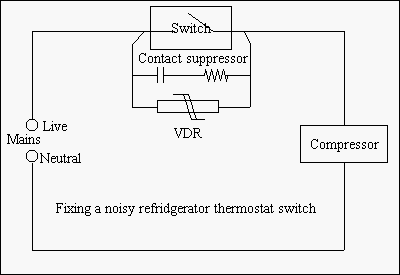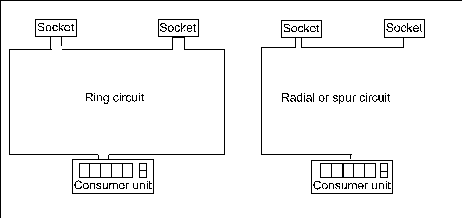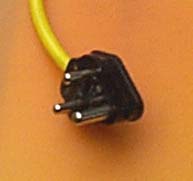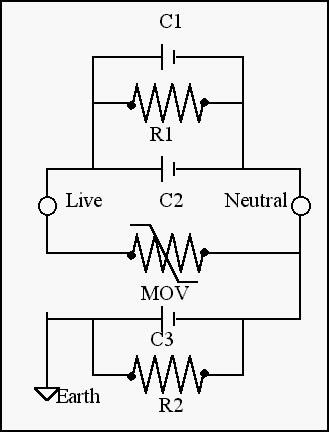|
Decibel Dungeon
|
|
|
|
IMPORTANT WARNING
Working with the mains electricity supply is potentially dangerous. If you are not a qualified electrician and you do not have the necessary experience, you should not attempt any work which involves mains electricity. The author takes no responsibility for any injury, death or damage to property that may occur as a result of implementing any of the following modifications.
|
|
It may come as a surprise that there is anything wrong with the supply of mains electricity in countries like the UK and USA. There is seldom a break in the supply and most of the time we can simply plug an item into a socket and use it without any problems.
|
|
With hi-fi equipment it is not only the availability of a continuous electrical supply that is important, but also the quality of that supply. Again, some people may be surprised that something like electricity can be discussed in terms of quality but there are a number of factors which affect its quality and suitability for powering hi-fi eqipoment. They are:
|
|
- Low voltage
- RFI (Radio Frequency Interference)
- Voltage spikes
- Fluctuating voltage (surges)
- High impedance
|
RFI - Electrical interference which is in the same frequency band as radio signals. Can enter the hi-fi chain via any connecting cables.
SPIKES - very sudden short bursts of voltage much higher than the normal (230 in UK) supply.
SURGES - periods of increased voltage but rising and falling more gradually than a spike
|
|
The causes of these problems are, unfortunately, many. Here are just some of them:
|
 |
- A high demand on the supply from a power station may cause the voltage levels to drop.
- Lightening strikes can cause extremely high voltage spikes, as can the operation of some types of electrical equipment.
- Electricity is carried along cables, all the way from the power station (which may be many miles away) to your home. All the cabling in between can and does act as a large ariel, picking up radio signals which interfere with the supply.
- Poor connections (especially to ground) cause clicks and bangs which can sometimes be heard coming from your loudspeakers.
|
|
To help you understand why a 'contaminated' electricity supply to your hi-fi affects the sound quality, we'll use the analogy of water. The electrical signal which is produced by the source component is tiny and needs to be amplified in order to be strong enough to drive the loudspeakers. This is achieved by adding more electricity to it (usually from the mains supply). Now if we start with a a pure signal (uncontaminated water) and add polluted electricity (dirty water) to it we will finish up with a contaminated signal. So the added electricity needs to be as clean or pure as possible. Using the water analogy, that means we need a clean supply with a constant rate of flow.
|
| Site menu
Page menu
|
|
|
|
|
There are a number of measures that can be taken to improve the electrical supply which we feed into our hi-fi equipment. If you are serious about getting the best out of your system, you should consider installing a dedicated power supply from your consumer unit.
|
DEDICATED POWER SUPPLY - A mains 'ring' or spur that supplies your hi-fi equipment and nothing else.
CONSUMER UNIT - The box which is connected to the meter and into which all the electrical circuits in the home are connected via fuses or circuit-breakers.
|
|
The amount of work (and disruption) this entails is dependent on where your listening room is in relation to your consumer unit, what kind of consumer unit you have, whether it has the capacity to add another circuit, and how easy it will be to install the new cables. I can say, from my own experience, that all the trouble and expense is worth it. Modifications to the electrical supply have made noticeable improvements to the sound of my hi-fi system. And remember, the final signal which drives your loudspeakers contains a higher proportion of added (mains) electricity than the original signal. So, no matter how good your equipment is, the sound will still be dependent on the quality of the power supply. Having a dedicated mains supply is the building platform on which you can continue to provide better power to your equipment.
|
|
A dedicated mains supply will isolate your hi-fi equipment from the rest of the electrical wiring in your home which may cause electrical interference. However, you should still make sure that the rest of the electrical system in your home is not producing any unwanted nasty effects. Make sure that the wires into each socket are secured and that the retaining screws are tightened. Check all earth wires are securely connected.
|
|
Make sure all your electrical appliances are in good working order and check that the wires in the plugs are secure and that the clamping screws are tight. Some appliances like refrigerators produce interference when the thermostat switches the cooling system on and off. This can usually be cured by fitting a contact suppressor and VDR across the contacts of the switch.
|
|

|
A competent electrician should be able to do this for you without too much trouble as the switches concerned are situated just inside the fridges main compartment. Dimmer switches can also cause clicks and pops and can be cured by the same method.
|
|
Make sure that all the mains leads on your hi-fi are in good condition and that the wires are securely held inside the plugs. It may sound daft, but it seems to improve the sound if you polish the pins of the mains plugs with a metal polish. Do the same with the fuses inside the plugs. The theory is that this makes for a better contact and lowers impedance but whatever the reason, it does seem to work. This polishing should be done about twice a year.
|
IMPEDANCE - very simply, the resistance offered to an alternating current or signal as the result of capacitance, inductance and resistance.
|
| Site menu
Page menu
|
|
|
|
|
There is nothing too technical about providing a dedicated mains supply to your hi-fi but if you don't feel competent to do the work yourself, you should call in a qualified electrician.
Please note that in some countries, this sort of work is illegal and may only be done by qualified electricians!
|
|
The job involves creating a new spur or ring from your consumer unit to your hi-fi. For the amount of current used by a hi-fi, there is probably no advantage in a ring over a spur, or visa versa. I have spoken to several qualified people on this matter and they have not expressed a preference for either circuit. I have settled for a spur.
|
|

|
|
You will need a spare fuse or circuit-breaker on your consumer unit to connect your new circuit to. If you don't have one then you will need to purchase a new consumer unit. If you have to do this, then consider buying one that uses the re-settable circuit-breakers. These make it much easier to restore the supply after a fault (you just flick a switch instead of having to re-wire the fuse), and they are generally considered to 'sound' much better. Going to the expense of buying a new consumer unit may seem a 'bit over the top' but compare it with the cost of a new piece of equipment and it does not look so bad. As a means of improving the sound of your hi-fi, this really is cost-effective as it will make all your equipment work better.
|
|
The new circuit can use ordinary mains cable but why not take things a step further while you are going to the trouble of installing it. You could use a screened cable to prevent further contamination by RFI. Another method is to use a plaited cable, where the three conductors: live, neutral and earth, are plaited together. This helps prevent RFI contamination. I used lengths of 50/.25mm stranded cable for this purpose.
|
SCREENED CABLE - A cable surrounded with a foil or copper mesh to prevent RFI reaching its' conductors. Said by some to be ever more necessary as the amount of radio signals from items like mobile phones, personal radios and wireless baby monitors etc increases.
|
|
Screened cable is available from suppliers like Farnell Electronics although unfortunately they don't sell shorter lengths. If you decide to purchase a reel anyway, the surplus can be used as mains leads for your hi-fi equipment.
|
|
As ever, you will find suppliers offering all kinds of exotic cables for building your dedicated ring or spur. Even if these cables did live up to the claims made for them, it would (IMHO) still not justify their cost.
|
|
At a suitable location close to your hi-fi, connect the cable from the consumer unit to a socket. Later, you can build or buy some distribution power blocks which will plug into this socket.
|
|
Your dedicated supply is not quite ready to use yet. First you should install an extra earth wire. Please note that this is in addition to the one connected to the consumer unit.
|
|
Using 6mm2 earth bonding wire, attach one end to the earth connection of your 'master' socket. The other end should be connected to a length of 22mm copper pipe which has been driven into the ground as far as possible (either under your floor or outside, which ever is easier to access). Alternatively attach the wire to a copper sheet (the bigger the better) which is buried deep in the ground. Make sure that the connections at both ends of this wire are secure and make maximum contact.
|
|
In addition, some audiophiles recommend fitting another earth connection from the output sockets, on say the preamp or CD player, to ground. This should use screened cable (50 ohm or 75 ohm types are OK). The conductor is connected to the equipment output sockets at one end and at the other to something like a decorators scraper which should be chrome-plated to prevent tarnishing. The cable at this end has its screening braid and conductors joined together and connected with a ring terminal and bolt to the scraper which is then placed in the ground, preferably where the surrounding soil is, and will stay, damp.
|
|
Finally, fit a 10 amp fuse or circuit-breaker in the consumer unit. Do not plug any 'non-hi-fi' items into this supply as you may be re-introducing interference and items rated higher than 10 amps will cause the supply to fail.
|
|
IMPORTANT If you have carried out the installation of a dedicated mains supply yourself, and you are not a qualified electrician, you should now get the circuit checked by someone who is qualified BEFORE you use it.
|
|
Inevitably, some suppliers of hi-fi 'upgrades' are now offering 'super' mains sockets, often standard items with some sort of extra plating of the contacts. Whether these perform any better than the standard items you get from your local electrical retailer, I can't say as I have never tried them.
|
|
I can say that I believe the 'super' versions to be inferior to the mains plugs and sockets which I use. These are the 'old' (UK) 15 amp plugs and sockets with the round pins. Ask any experienced electrician and they will tell you that these are far superior to the modern (UK) 13 amp plugs and sockets with their rectangular pins. Close examination of the round-pin system will reveal a much larger contact area between the plug and socket receptacle. And you only have to polish up the pins of the plug to see that the surface is much smoother than even the plated 'super' plugs.
|
|
If you can get these 15 amp items, I thoroughly recommend them and as mine all came from boot sales and cost only a few pence each, they were cheaper than even the standard 13 amp equivalents!
|
|

Best quality for a few pence!
|
|
One word of warning though; the 15 amp plugs are not fused like the modern 13 amp equivalents. This means that your power lead is not protected in the event of a short circuit. Providing that you make sure that the leads are in perfect condition, this should not cause a problem. Most of the 15 amp sockets were switched but the switch mechanism can be bypassed by soldering copper wire across the switch contacts. Use copper wire stripped from 2.5mm2 cable.
|
|
Here's some interesting information sent to me by a Decdun visitor, Tony Spires:
As this topic doesn't appear to be covered I would like to offer input based on my own findings with my own system, for a while now I have been running my system on standard run of the mill fuses from the likes of SEM Bussman Atlas and Vernons after various mains upgrades like leads and plugs which didn't really make a big difference to the sound.
But what did make a big difference was the rating and make of fuse I used in the various mains extensions so took the plunge and bought an AMR gold fuse although different I would not go so far as to say it made the sound better so after a lot of experimenting I found it is not one particular brand of fuse that compliments a system but how one fuse compliments another so trying different makes and values in different positions in extensions etc can produce dramatic results one thing I have noticed while experimenting with mains fuses is a 3amp will make the sound thin and weightless and a 5A not much better while a 13 amp can make it sound dull, boomy and lifeless if used anywhere except at the wall socket, for any extension blocks etc I would recommend trying a 10A or 7A rated fuse but try as many off the shelf brands as you can it's cheap and you might be surprised how much difference it can make another surprising effect of the mains fuse can be left right balance and centre staging.
So experimenting with fuses is something else to try although you should remember that a fuse is rated for the equipment that it is protecting, and using a different value may well remove that protection. As always with mains electricity, dont' do anything that you are not 100% sure about.
|
| Site menu
Page menu
|
|
|
|
|
Another one of hi-fi's fashions, mains conditioning seems to come and go. I would suggest that as the mains electricity supply becomes more polluted, that every audiophile should consider using something to improve the mains supply to their hi-fi equipment.
|
|
In their most simple forms, mains conditioners are some sort of electrical filter, designed to remove the spikes and other nasties from the AC supply. Over the years, different designs have been put forward as being the best although I think that it would be very difficult to compare them all objectively. From my own experience, some sort of mains conditioner does improve sound quality. The difference is quite large in my system but living in a town, with a couple of amusement arcades on the same local supply (megaloads of switching etc), there is probably plenty of room for improvement. How well one would work in your system depends on how polluted your supply is now.
|
|
I'm currently using a conditioner built from a kit. The design was originally published in 'ETI' magazine in 1988 and I am pleased to say that I have been given permission to reproduce the original ETI article by Mike Kenward, the Editor of 'Everyday Practical Electronics' magazine (who took over ETI) which is published by Wimborne Publishing Ltd. Click HERE for the article.
|
|
|
|
Briefly, the unit contains a number of VDR's which remove the damaging effects caused by high energy transients on the mains. There's also filters to remove RF interference, common mode interference and differential mode noise. Another part of the circuit is designed to display the nasties on the mains by means of an LED display but this doesn't seem to work on mine (unless there aren't any?)
|
VDR - stands for Voltage Dependent Resistor. These devices increase their resistance as the voltage flowing through them increases. In other words, up to a certain (pre-defined) voltage they do nothing but when the voltage goes over that level they increase resistance to 'hold it back'.
|
|
As ever, DON'T build something like this if you are not sure what you are doing. Find someone who is used to handling mains equipment and get them to build it for you (or buy one ready built). The unit can be built into a plug-top housing or a box with a lead and plug. It is simply plugged in to a spare mains socket next to your hi-fi.
|
|
Here's another conditioner design which seems to be widely available on the 'net'. I have not tried this one myself (yet) but a friend who has says it works well for him. Be warned though that there is a large in-rush of current when the unit is connected to the mains which causes a spark. Providing that the unit is built correctly into an insulated housing this won't harm you but it will probably give you a nasty fright.
|
|

A mains conditioner
|
C1 = 8 ufd 250v AC (motor start capacitor)
R1 & R2 = 220k 2Watt
MOV = 275v 9 or 12mm dia disk
C2 & C3 100n 500V AC
|
|
Another device used for mains conditioning is the isolation transformer. For a full explanation of isolation transformers click HERE
Isolation type mains conditioners can be purchased from Trichord Research. They have overcome the main problem I have with these devices, ie not being able to audition them at home. Trichord offer you your money back if you don't think that their product meets their claims.
|
| Site menu
Page menu
|
|
|
|
|
You may be wondering if you could avoid all the problems associated with the mains electricity supply if you were to use batteries to power some or all of your hi-fi. Although this initially seems like the ideal solution, there are some drawbacks.
|
|
The first problem (for all of us working on a tight budget) is the cost. To power a whole hi-fi system with batteries would require such a large number that the cost is really prohibitive. Even using batteries for a few items is expensive as you will probably want to have two sets so that one can be recharged while the other is in use. Add to the cost of the batteries the cost of a special charger (you can't use the type normally used for motor car batteries) and it all gets quite expensive compared to a mains power supply.
|
|
When considering a battery power supply it should also be remembered that these are not the perfect sources of electrical power that they are sometimes reputed to be. There is some electrical noise produced by the chemical reactions in the battery. Having said that, this noise is considerably less than you will get from mains electricity. The choice will probably come down to the cost of the batteries and charger. Substituting a battery power supply for a mains one isn't too difficult but care should be taken to make sure that the voltage supply is not changed.
|
|
If you want to try a battery power supply, you could start with a piece of equipment with comparatively small demands like a phono stage or electronic crossover. Items like (most) power amplifiers require far more power and are less often converted for use with batteries.
|
| Site menu
Page menu
|
|
|


